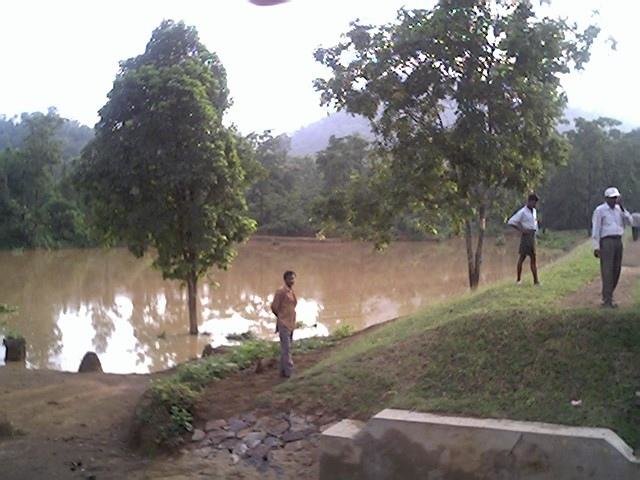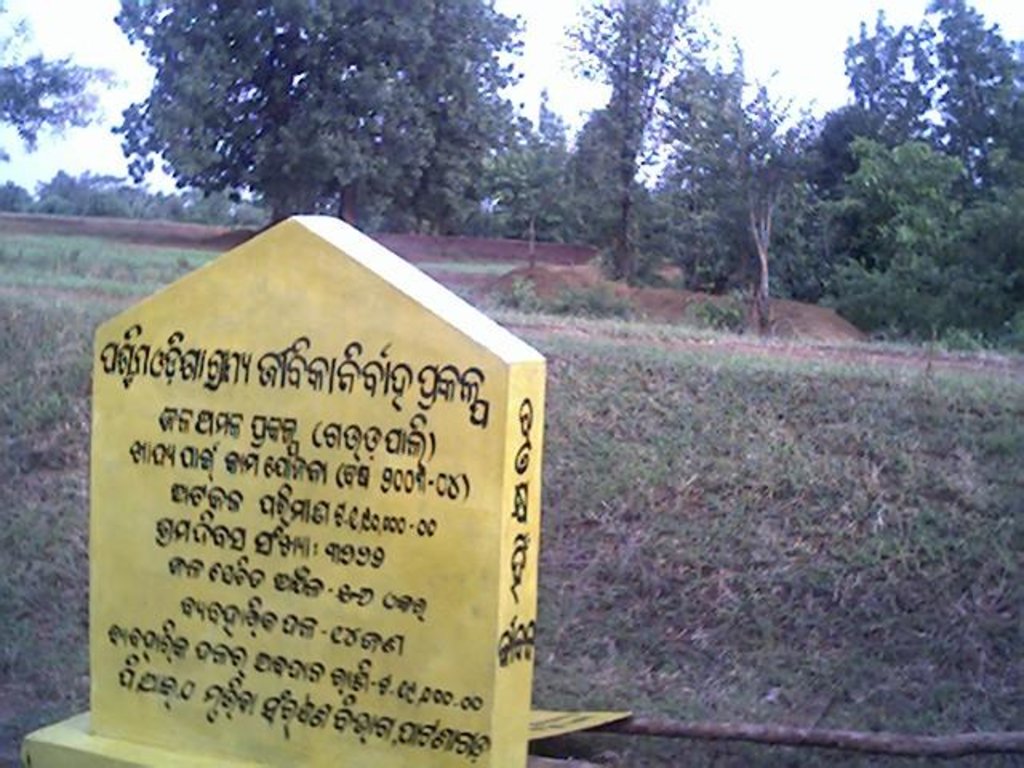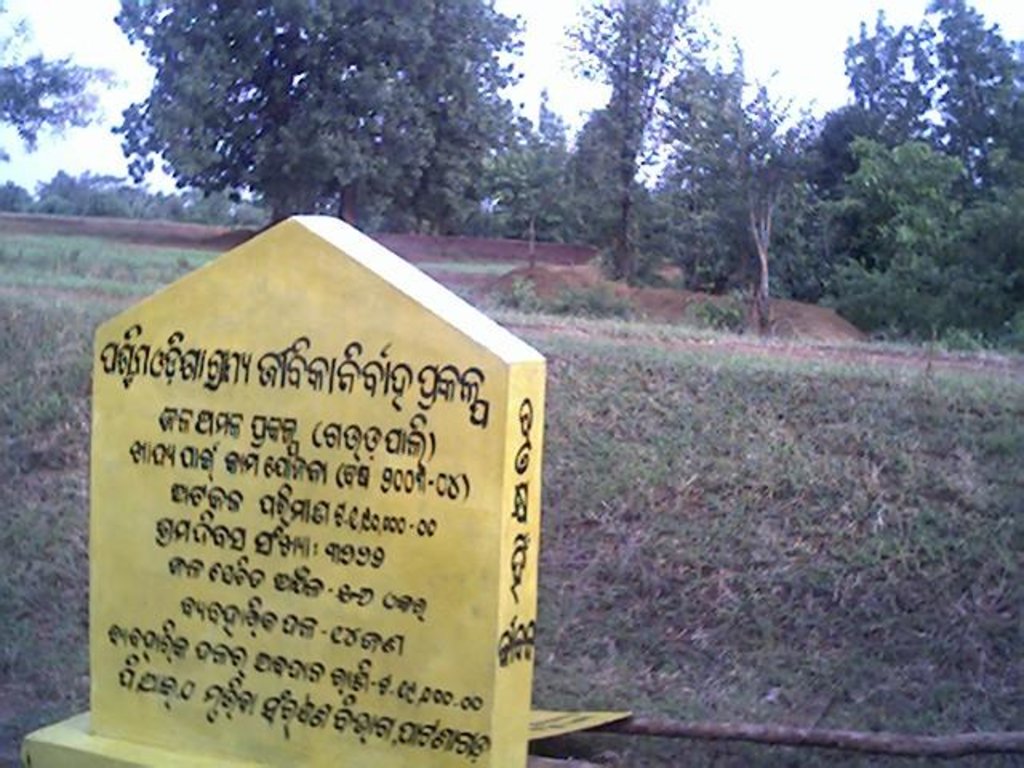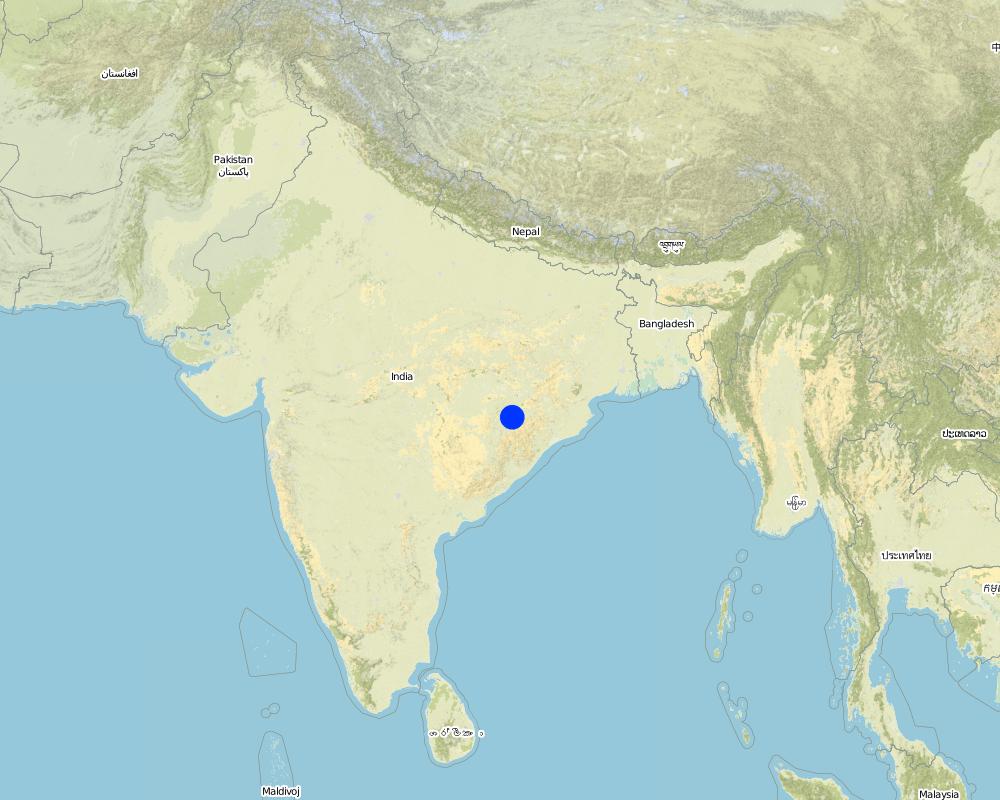Community based sustainable livelihoods [الهند]
- تاريخ الإنشاء:
- تحديث:
- جامع المعلومات: Unknown User
- المحرر: –
- المُراجع: Fabian Ottiger
approaches_2371 - الهند
عرض الأقسام
توسيع الكل طي الكل1. معلومات عامة
1.2 تفاصيل الاتصال بالأشخاص الرئيسيين لمصدر المعلومات والمؤسسات المعنية بتقييم وتوثيق النهج
الشخص (الأشخاص) الرئيسي لمصدر المعلومات
متخصص في الإدارة المستدامة للأراضي:
Mohanty Rajib Kumar
الهند
1.3 الشروط المتعلقة باستخدام البيانات الموثقة من خلال WOCAT
يوافق جامع المعلومات والشخص (لاشخاص) الرئيسي لمصدر المعلومات على الشروط المتعلقة باستخدام البيانات الموثقة من خلال WOCAT:
نعم
1.4 المراجع الخاصة باستبيان(استبيانات) تقنيات الإدارة المستدامة للأراضي

Dug-out sunken pond cum countour bund [الهند]
It can be defined as combination of structural & vegetative measures where contour bunds are constructed from the excavated sandy loam soil of cultivated wastelands in semi-arid climatic(?) zone with moderate slope in medium soil depth conditions in order to link with self-subsistance & market oriented production systems from private …
- جامع المعلومات: Unknown User
2. وصف نهج الإدارة المستدامة للأراضي
2.1 وصف موجز للنهج
Sustainable livelihoods enhanced through people's organisations by linking with other resource organisations prticularly for resource poor.
2.2 وصف تفصيلي للنهج
وصف تفصيلي للنهج:
Aims / objectives: The name of the project is western orissa rural livelihoods project, supergoal-reduction of poverty in rainfed areas of India, goal- More effective approaches to sustainable rural livelihoods adopted by government agencies & other stakeholders in KBK districts & elsewhere. The overall purpose is sustainable livelihoods, particularly fo the poorest, promoted in 4 districts in replicable ways by 2010 & to reduce poverty by promoting livelihoods initiatives particularly resource poor. Unlike DFID(I)'s earlier rural development projects, WORLP will work within government & follow GOI's watershed guidelines, but extra resources for ' watershed plus' activities: capacity building, minor irrigation, drinking water & livelihood initiatives for the poorest. WORLP is a part of wider effort to help Ministry of Rural Development (MoRD) improve the effectiveness of watershed work nationally;'watershed plus' approach developed in WORLP will be tested for wider replication.
Methods: The project will have basically four types of impact: production impact, employment impact, Poverty alleviation impact & capacity building impact.The project would directly reavh a population of 725,000 people, 80% of whom would be people below poverty line-landless, marginal & small farmers. The Director of the Watershed Mission will answer to an empowered committee chaired by the Chief Secretary; district level will be strenghthened by the appointment of a Project Director-Watershed projects & staff to work alongside the District Rural Development Agencies, funds will be tranferred from the PD-DRDA to the PD-WSP; GoO has appointed full time watershed development teams at block level to support implementation of the KBK plan; WORLP may use these teams, but can also use other government agencies(including Forestry Department in areas with forest land) or NGOs as PIAs. DFID will finance a Project Support Unit at Bhubaneswar, Capacity Building Teams in districts & Livelihood Support Team at block level. The project will fall under state leve Watershed Mission, created to oversee implementation of all MoRDIts main focus is to work with existing strengths & build upon them. In this area 60 to 70% of th population live below official poverty line. Erratic rainfall, limited irrigation, poor capacity of government agencies & restricted opportunities for non-land based activities are major factors. But the key to poverty seems to be the structure of social relations: caste, untouchability, skewed land distribution, land alienation, dependence on money lenders, encroachment on common property resources, gender issues, all of which prevent access by pooe groups to natural resources.
2.3 صور عن النهج
2.5 البلد/المنطقة/المواقع التي تم تطبيق النهج فيها
البلد:
الهند
المنطقة/الولاية/المحافظة:
ORISSA
Map
×2.6 تواريخ بدء وإنهاء تنفيذ النهج
أشر إلى سنة البدء:
2001
سنة الإنهاء (إذا لم يعد النهج مطبقًا):
2010
2.7 نوع النهج
- قائم على مشروع/برنامج
2.8 الغايات/الأهداف الرئيسية للنهج
The Approach focused mainly on SLM with other activities (organising the people in general, & poor (defined by the criteria of villagers), analysis of of problems, constraints, opportunities, threat concerning five capitals like physical, social, natural, finacial & human &)
The objectives of the project approach are mainly three components. Promoting livelihoods improvements, capacity building of primary & secondary stakeholders & encouraging an enabling environment.
The SLM Approach addressed the following problems: Coping strategy against Drought, distressed migration, income in the lean period. Other problems are like employment opportunities, farm & non-farm activities for lan users & landless.
2.9 الظروف التي تمكن أو تعيق تنفيذ التقنية/التقنيات المطبقة بموجب النهج
المعايير والقيم الاجتماعية /الثقافية/ الدينية
- معيق
Unity & transparency
Treatment through the SLM Approach: Awareness, training, exposure visits,Regular rapport building etc.
توفر/الوصول إلى الموارد والخدمات المالية
- معيق
Capital for initiatiation of any activities.
Treatment through the SLM Approach: Project fund
الإطار المؤسساتي
- معيق
People's organisations not strenghthened
Treatment through the SLM Approach: Formation of institution like Self help group, User group, Watershed committee, Community link workers.
الإطار القانوني (حيازة الأراضي، وحقوق استخدام الأراضي والمياه)
- معيق
Legal provisions like access to Common property resource, rights on assets created etc.
Treatment through the SLM Approach: capacity building on legal provisions.
The existing land ownership, land use rights / water rights moderately hindered the approach implementation operational holdings are highly skewed, appr. 30% of households are landless, & 40-50% are small & marginal farmer, land allienation is wide spread because of indebtedness. Motgaging the land is the outcome due to heavy dependence on private money landers charging unserious rate of interest. Skewed control of land & water. Officially 10% of people own 35% of project area land, inreality appr. 60%
المعرفة حول الإدارة المستدامة للأراضي، والوصول إلى الدعم الفني
- معيق
Estimates, lay-out & planning
Treatment through the SLM Approach: Regular training to volunteers to create a bare-foot professionals in the village.
غير ذلك
- معيق
Community mobilisation
Treatment through the SLM Approach: Common meeting, focus group discussion, adressing household problems.
3. المشاركة وأدوار الأطراف المعنية
3.1 أصحاب المصلحة المعنيون بالنهج وأدوارهم
- مستخدمو الأراضي المحليون/المجتمعات المحلية
Wok equally divided between men and women (User's group or Area group mainly men, as most of the land is on the name of men. Self help groups are mainly from women. Although women participated in decision making process & also in the activities, but still men take the important decisions particularly for SWC measures. Perhaps mostly the lands are owned by men. Therfore, participation of men in comparison to women for SWC measures is more. In this connection, villagers opine that women participated benevolently for the first time for planting of seedlings. Some landless goup receives uncultivated wate land in meagre amount 0.5 ha whose land is part of the patch. Nextly representative from th resource-poor & very poor category as per the defined criteria of the villagers are also member of the watershed committee. As the watershed committee mainly responsible for any work because the money flows directly to the watershed committee account.
- الحكومة الوطنية (المخططون، صانعو القرار)
- منظمة دولية
A project implemnting agency is appointed at the block level
إذا كان هناك العديد من الأطراف المعنية، قم بالإشارة إلى الوكالة الرائدة:
A team of international & national specialist did the study of the four poverty stricken districts of the state. Than they drafted the Project meomrandum which is a broader framework of guidelines stating the robust processes. But it is so flexible in nature that it has every scope for modification as required or desired by the landusers.
3.2 انخراط مستخدمي الأراضي المحليين/المجتمعات المحلية في المراحل المختلفة للنهج
| انخراط مستخدمي الأراضي المحليين/المجتمعات المحلية | حدد من شارك وصف الأنشطة | |
|---|---|---|
| المبادرة/التحفيز | سلبي | public meetings; People started participating because root cause of every problem becomes clear to the community. Interaction with all villagers again & again through public contacts |
| التخطيط | سلبي | rapid/participatory rural appraisal; Planning at time of drafting of micro-plan the land users went for transact of the area along with SWC specialist to sense the problem & alternative solutions. |
| التنفيذ | الدعم الخارجي | Mainly: responsibility for minor steps; partly: casual labour; The implementation of the SWC was done by the User's group with supervision of Watershed committee. The Watershed committee provide cheque to the User's group. |
| الرصد/التقييم | غير موجود | Mainly: measurements/observations; partly: reporting; The monitoring is done at time of measurements/observation by the secretary & watershed committee. The rgular reporting was done by the watershed development team. |
| Research | التعبئة الذاتية | on-farm; On-farm demos of the agriculture, integrated nutrient management, intercropping & line sowing etc. |
3.4 اتخاذ القرار بشأن اختيار تقنية/تقنيات الإدارة المستدامة للأراضي
حدد من الذي قرر اختيار التقنية/التقنيات التي سيتم تنفيذها:
- مستخدمو الأراضي بشكل أساسي، بدعم من متخصصي الإدارة المستدامة للأراضي
اشرح:
Firstly the Project implementing agency & team initiate the discussion in different ways, like training, exposure visits, focused group discussion.The first phase is called rapport building phase for one year, when the livelihood focused micro-plan is prepared. The micro-plan can be modified time to time as per the need & concern of the community.
Decisions on the method of implementing the SLM Technology were made by mainly by land users supported by SLM specialists. In this approach in general & SWC measures in particular, firstly the land user's group raise proposal before the committee. The criteria behind the selection is poor land, poor people, contribution & ridge to valley approach. Than the land users agree to
4. الدعم الفني وبناء القدرات وإدارة المعرفة
4.1 بناء القدرات/التدريب
هل تم تقديم التدريب لمستخدمي الأراضي / الأطراف المعنيين الآخرين؟:
نعم
حدد من تم تدريبه:
- مستخدمو الأراضي
- SWC specialists (1), extensionists/trainers (2), planners (3)
شكل التدريب:
- في العمل
- من مزارع إلى مزارع
- مناطق العرض
- اجتماعات عامة
- دورات
المواضيع المغطاة:
Reconnainance survey through maps. Transact of the area, Identification of root cause of the problem & alternative solution & demonstration of different items so that the land users get a basket of choices. Another objective of the project to develop volunteers who will get some remuneration & help the land users for future maintainance, estimate, lay-out etc.
4.2 خدمة استشارية
هل يملك مستخدمو الأراضي وصولا إلى خدمة استشارية؟:
نعم
حدد ما إذا كانت الخدمة الاستشارية متوفرة:
- في حقول مستخدمي الأراضي
وصف/تعليقات:
Name of method used for advisory service: Community based sustainable livelihoods.; Key elements: Amalgamation of social & natural resource., Agreement of User's grop, benefit sharing, conflict resolution, prioritisation, etc., Farmer to farmer extension, replication through 'learn by doing & teach by showing methods'; 1) Advisory service was carried out through: government's existing extension system, projects own extension structure and agents; Extension staff: mainly government employees 3) Target groups for extension: land users; Activities: Participatory resource mapping through T
Advisory service is inadequate to ensure the continuation of land conservation activities; It is because it is really to early to conclude about extention. It requires high degree of common sense & commitment. Although extension service is in place but it needs coordination & management which will be hopefully developed by the project within next 3-4 years.
4.3 تعزيز المؤسسات (التطوير التنظيمي)
هل تم إنشاء أو تعزيز مؤسسات من خلال هذا النهج؟:
- نعم، إلى حد كبير
حدد المستوى (المستويات) التي تم فيها تعزيز أو إنشاء المؤسسات:
- محلي
حدد نوع الدعم:
- مالي
- بناء القدرات/التدريب
- معدات
4.4 الرصد والتقييم
هل يشكل الرصد والتقييم جزءا من النهج؟:
نعم
التعليقات:
bio-physical aspects were regular monitored through observations
technical aspects were regular monitored through observation
socio-cultural aspects were ad hoc monitored through observations
economic / production aspects were ad hoc monitored through observations
There were many changes in the Approach as a result of monitoring and evaluation: By timely monitoring & evaluation, the stages of the linked institutions are determined & capacity building was determined time to time. Fo example a training to SWC/NRM volunteers, supervision was done after regular interval. Than again after a time period the refresher training was devised as per the receptance of the concerned volunteers.
4.5 البحوث
هل كانت البحوث جزءًا من النهج؟:
نعم
حدد المواضيع:
- علم الاجتماع
- الاقتصاد / التسويق
- تكنولوجيا
أعط تفاصيل إضافية وأشر إلى من قام بالبحوث:
Participatory technology development with proper admixture of social & natural resouce is one of the objective of the project. As the components of technology, social dynamics & economics are interwoven with each other, therefore, research through consultants of national & international repute is a regular part of the project process.
Research was carried out on-farm
5. التمويل والدعم المادي الخارجي
5.1 الميزانية السنوية لمكون الإدارة المستدامة للأراضي في النهج المذكور
إذا لم تكن الميزانية السنوية الدقيقة معروفة، قم بالإشارة إلى نطاقها:
- < 2000
التعليقات (على سبيل المثال المصادر الرئيسية للتمويل/الجهات المانحة الرئيسية):
Approach costs were met by the following donors: international (DFID): 100.0%
5.2 الدعم المالي/المادي المقدم لمستخدمي الأراضي
هل حصل مستخدمو الأراضي على دعم مالي/ مادي لتنفيذ التقنية/ التقنيات؟:
نعم
5.3 إعانات لمدخلات محددة (بما في ذلك العمالة)
- معدات
| حدد المدخلات التي تم دعمها | إلى أي مدى | حدد الإعانات |
|---|---|---|
| أدوات | ممول جزئيا | |
- زراعة
| حدد المدخلات التي تم دعمها | إلى أي مدى | حدد الإعانات |
|---|---|---|
| Seedlings | ممول بالكامل | |
- بنى تحتية
| حدد المدخلات التي تم دعمها | إلى أي مدى | حدد الإعانات |
|---|---|---|
| Community infrastructure | ممول بالكامل | |
التعليقات:
The unit of the project is a watershed & the project cost is rs. 9,500 per hac, out of which around rs. 3,600/ is for direct SWC measures & rest is for enhancement of livelihood assets & linking to self-sustainable institutions.
5.4 الائتمان
هل تم توفير ائتمان في إطار نهج أنشطة الإدارة المستدامة للأراضي؟:
نعم
حدد الشروط (معدل الفائدة، فترة السداد، الخ.):
Interest rate charged: 8.0%; repayment conditions: From the project side it one time grant to the watershed committee. But the watershed committee gives loan to groups or individual as per their own norms & condition. As the the project is trying to have a revolving fund in the watershed level for future mainatinance & requirement..
Interest was lower than market rate.
حدد متلقي الائتمان:
The person who will avail loan must be in aself help group & must pass through the grading process w
6. تحليل الأثر والتصريحات الختامية
6.1 آثار النهج
هل ساعد النهج مستخدمي الأراضي على تنفيذ وصيانة تقنيات الإدارة المستدامة للأراضي؟:
- لا
- نعم، قليلا
- نعم، باعتدال
- نعم، إلى حد كبير
The crop-diversification like change from the minor millets to cash crop & paddy. The land where only one crop season, but now they are taking up two crops, like kharif & pre-Rabi crops etc.
هل أدى النهج إلى تحسن في مسائل حيازة الأراضي / حقوق المستخدمين التي أعاقت تنفيذ تقنيات الإدارة المستدامة للأراضي؟:
- لا
- نعم، قليلا
- نعم، باعتدال
- نعم، إلى حد كبير
Villagers are classified under 4 categories, well-off, manageable, poor & very poor as per the criteria developed by villagers. For the project norms except well-off all are target group. At that time the contribution from a resource rich farmer was collected cash. The resource poor farmers were given a period of time & collected out of contribution of labour.
Did other land users / projects adopt the Approach?
- لا
- نعم، قليلا
- نعم، باعتدال
- نعم، إلى حد كبير
It is very difficult to quntify in this stage. But the reprentatives of nearly 15 Project areas visited under exposure visits. The Project implementing agencies of other districts states also visted & learnt the technology & outcome of the technology in form of production from the land, crop-diversification.
6.3 استدامة أنشطة النهج
هل يمكن لمستخدمي الأراضي المحافظة على استدامة ما تم تنفيذه من خلال النهج (بدون دعم خارجي)؟:
- غير مؤكد
إذا كان الجواب لا أو غير متأكد، حدد ذلك وعلق عليه:
It is because although it was hoped but one project cycle of 5 years is not over to give concluding remarks.
6.4 نقاط قوة/مزايا النهج
| نقاط القوة/ المزايا/ الفرص من وجهة نظر جامع المعلومات أو غيره من الاشخاص الرئيسيين لمصدر المعلومات |
|---|
| Equity in investments, with a particular focus on developing SWC on the land of small & marginal farmers, often in the upper catchment. (How to sustain/ enhance this strength: The review & montoring as per the micro-plan developed by the villagers of the watershed.) |
| Generating employment for those most in need in the early phases to provide immediate relief from indebtedness & impoverishment & need to migrate. |
| A group approach built around the establishment of revolving fundsto provide alternative credit sources. Site specific approaches ranging from rainfed SWC measures to increasing |
7. المراجع والروابط
7.1 طرق جمع/مصادر المعلومات
- زيارات ميدانية، مسوحات ميدانية
- مقابلات مع مستخدمي الأراضي
الروابط والوحدات المواضيعية
توسيع الكل طي الكلالروابط

Dug-out sunken pond cum countour bund [الهند]
It can be defined as combination of structural & vegetative measures where contour bunds are constructed from the excavated sandy loam soil of cultivated wastelands in semi-arid climatic(?) zone with moderate slope in medium soil depth conditions in order to link with self-subsistance & market oriented production systems from private …
- جامع المعلومات: Unknown User
الوحدات المواضيعية
لا يوجد وحدات مواضيعية





